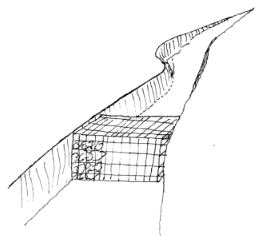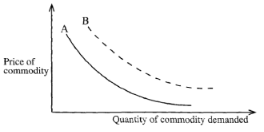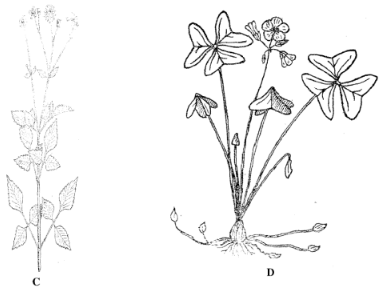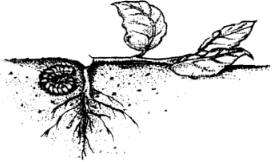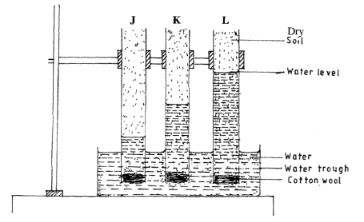SECTION A (30 marks)
Answer ALL the questions in this section in the spaces provided
- Name the part harvested for each of the following craps:
- onions (½ mark)
- carrots (½ mark)
- coffee (½ mark)
- State four biotic factors that influence crop production (2 mark)
- Name four methods of controlling Top pests. (2 mark)
- State four ways of harvesting water on the farm. (2 marks)
- Name four farm records that should be kept by a poultry farmer. (2 marks)
- State four disadvantages of using organic manure in crop production.
- Give two ways in which pastures are classified (1 mark)
- State four disadvantages of organic mulches. (2 marks)
- Give five advantages of practising crop rotation. (2 marks)
- State two advantages of earthing up in crop production (1 mark)
- Give four harmful effects of weeds on crop production (2 marks)
- State three advantages of shifting cultivation. (1½ marks)
- Give five advantages of zero grazing in dairy farming. (2½ marks)
- State four factors that determine the stage at which a crop is harvested, (2 marks)
- State four ways in which land reform can be implemented in Kenya, (2 marks)
- Give four factors that influence the number of secondary cultivations in seedbed preparation. (2 marks)
SECTION B (20 marks)
Answer ALL the questions in this section in the spaces provided
- The illustration below shows a structure used for controlling soil erosion. Study it carefully and answer the questions that follow.
- Identify the structure. (1 mark)
- Explain two ways in which the structure helps to control soil erosion. (2 marks
- The diagram below illustrates the law of demand in agricultural marketing. Study it and answer the questions that follow.
- Give a reason for the shape of the curve labelled A. (1 mark)
- If the price of the commodity remains constant, explain three factors that can cause the curve to shift from A to B (3 marks)
- The diagrams below illustrate common weeds in arable land. Study them carefully and answer the questions that follow.
- Identify the weed labelled D. (1 mark)
- Classify the weed labelled according to plant morphology. (1 mark)
- Give one reason why it is difficult to control the weed labelled D. (1 mark)
- The diagram below illustrates an agroforestry practice. Study it and answer the questions that follow
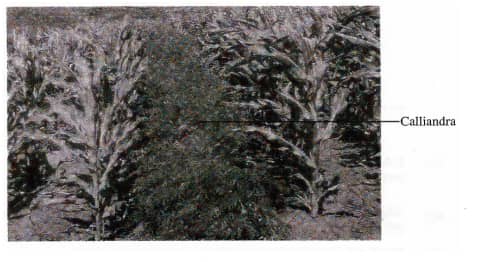
- Identify the agroforestry practice illustrated above. (1 mark)
- Explain three benefits of the practice illustrated above. (3 marks)
- The diagram below shows a pest and the damaged crop. Study it and answer the questions that follow.
- Identify the crop pest illustrated above. (1 mark)
- Explain two ways of controlling the pest. (2 marks)
- The diagram below illustrates an investigation on a property of soil using soil samples labelled J. K and L.
- If the levels of water shown in the diagram were observed after three hours, name the property of soil being investigated. (1 mark)
- What is the relationship between the soil property named in (a) above and the size of soil particles?(1 mark)
- Which soil sample would be suitable for growing paddy rice? (1 mark)
SECTION C (40 marks)
Answer any TWO questions from this section in the spaces provided after question 25.
-
- Explain five factors that should be considered in farm planning. (10 marks)
- Describe the transplanting of tomato seedlings. (10 marks)
-
- Explain five factors that should be considered when siting a vegetable nursery (5 marks)
- Explain six factors that should be considered when selecting seeds for planting (6 marks)
- Explain the different ways in which each of the following environmental factors influence crop production:
- temperature; (4 marks)
- wind. b (5 marks)
-
- Outline the information contained in a Purchase Order (5 marks)
- Describe the harvesting of tea. (6 marks)
- Explain the importance of irrigation in crop production (5 marks)
- Describe the role of magnesium in crop production. (4 marks)

MARKING SCHEME
SECTION A
- Name the part harvested for each of the following crops:
- onions - bulb/ leaves
- Carrots - roots
- coffee - berry/ chimes/ fruits
(3 x ½ = 1½marks)
- Biotic factors that influence crop production.
- Pests
- Decomposers
- Pathogens
- Nitrogens
- Pollinators
- Weeds
- Predators
(4 x ½ = 2 marks)
- Methods of controlling crop pests.
- Chemical
- Biological
- Cultural
- Physical/ mechanical
- Legislation
(4 x ½ = 2 marks)
- ways of harvesting water on the farm.
- Roof catchment
- Rock catchment.
- Weir/ dam
- Retention ditches/ level terraces.
- Micro – catchment.
- Water parts/ ponds
(4 x ½ = 2 marks)
- Farm records that should be kept by a poultry farmer.
- Egg production
- Labour records
- Feeding records
- Health records
- Marketing records
- Inventory records
(4 x ½= 2 marks)
- Disadvantages of using organic manure in crop production
- Low nutritive value per unit volume/ weight.
- Livelihood of spread of disease/pest/weeds.
- Bulky are difficult to store/transport/apply.
- Looses nutrients if poorly stored
- Variable in nutrient content.
- Difficult to qualify amount of nutrients per unit volume.
(4 x ½ = 2 marks)
- Ways in which pastures are classified.
- Pasture stand; Pure/mixed.
- Pasture establishment/ natural artificial
- Ecological zone/altitude.
(2 x ½= 1mark)
- Disadvantages of organic mulches.
- Expensive to transport and apply/bulky
- Could be a fire risk.
- Provides breeding ground/hiding place for pests
- Intercepts light showers of rainfall.
- Can spread pests/weeds/diseases
(4 x ½ = 2 marks)
- Advantages of practicing crop rotation.
- Ensures maximum utilization of nutrients.
- Controls build –up of pests/diseases/controls pests/diseases
- Controls weeds that are specific to particular crops/ controls weeds.
- Improves soil fertility when leguminous crops are included.
- Controls soil erosion when cover crops are included
- Improves soil structure if grass lay included
(5 x ½ = 2½ marks)
- Advantages of earthing up in crop production.
- improves tuber formation/ tuber expansion/ root formation
- Improves drainage around the crop
- Conserves water/soil
- Facilitates harvesting of tuber crops
- Root protection
(2x ½ = 1 mark)
- Harmful effects of weeds on crop production.
- Lower crop yields
- Lower quality of crop products
- Some harbor crop pests/diseases
- Increase the cost of production
- Suppress growth of crops through competition for light, space.
- Some are parasitic to crops
- Some block irrigation channels
(4 x ½ = 2 marks)
- Advantages of shifting cultivation.
- No pest and disease build-up
- Low capital requirement
- No land disputes as land ownership is not individualized.
- Soil structure is maintained
- Give time for land fore gain fertility.
(3 x ½ = 1 ½marks)
- Advantages of zero grazing in dairy farming.
- Quick accumulation of manure
- Animal produce high yield due to less wastage of energy.
- Its easy to control diseases/parasites.
- Requires little land
- Allows higher stocking rate.
- Animal use feeds without wastage.
(5 x ½= 2½ marks)
- Factors that determine the stage at which a crop is harvested.
- Market price
- Weather conditions
- Market demand
- Purpose /intended use.
- Concentration of required chemicals
(4 x ½ = 2 marks)
- Ways in which land reform can be implemented in Kenya.
- Land consolidation
- Land adjudication and registration
- Land settlement and resettlement
- Tenancy reform
- Redistribution of land.
- Improved land legisltation
- Sub – division
(4 x ½ = 2 marks)
- Factors that influence the number of secondary cultivation in seedbed
- preparation.
- Type of crop to be established/size of seed
- Moisture content of soil
- Type of soil
- Conditions of land after primary cultivation/ implements used for primary cultivation
- Amount of organic matter on the surface.
- Vulnerability of soil erosion/ slope of land/topography.
(4 x ½ = 2 marks)
SECTION B
-
- Identify the structure
- Gabion/porous dam (1mark)
- Ways in which the structure helps to control soil erosion.
- Slows down the spread of water thus reducing its erosive power.
- It traps the detached soil particles. (2 x 1 = 2 marks)
- Identify the structure
-
- Give a reason for the shape of the curve labelled A.
- As the price of the commodity increases the quantity demanded decreases and vice versa.(1x1=1mark)
- If the price of the commodity remains constant, explain three factors that can cause the curve to shift from A to B.
- If there is an increase in the income of consumers.
- Effective advertisement/sales promotion
- Increase in the price of a related/substitute
- If there is an increase in population
- Taste and preference
- If the quality of the commodity goes up
(3 x 1 = 3marks)
- Give a reason for the shape of the curve labelled A.
-
- Identify the weed labelled D.
- Oxalis spp./ oxalis latifolia/oxalis (1mark)
- Classify the weed labelled C according to plant morphology.
- Broad – leaved weed. (1mark)
- Reason why it is difficult to control the weed labelled D. (1mark)
- Presence of underground bulbs.
- Identify the weed labelled D.
-
- Identify the agroforestry practice illustrated above. (1mark)
- Alley cropping/hedge row/ hedger row intercropping.
- Benefits of the practice illustrated above. (3 x 1= 3marks)
- source of folder when tree foliage is cut and fed to livestock.
- Improves soil fertility through nitrogen fixation/nutrients re-cycling
- Facilitates soil and water conservation when roots bind soil particles/ improves soil structure
- Source of mulch/ material/ compost material.
- Identify the agroforestry practice illustrated above. (1mark)
-
- Identify the crop pest illustrated above. (1mark)
- Cutworm/ agrotis spp.
- Ways of controlling the pest
- Early planting for crop to establish early and outgrow the pest.
- Application of appropriate pesticide/ insecticide/ chemical to kill it
- Field hygiene to prevent transmission from previous crop residues.
- Physical killing and destruction (2marks)
- Identify the crop pest illustrated above. (1mark)
-
- Name the property of soil being investigated. (1mark)
- Soil capillarity
- What is the relationship between the soil property named in (a) above and the size of soil particles? (1mark)
- The smaller the size of the particles the greater the force of capillary.
- Which soil sample would be suitable for growing paddy rice? (1mark)
- soil labelled L.
- Name the property of soil being investigated. (1mark)
SECTION C (40 marks)
-
- factors that should be considered in farm planning.
- Environmental factors/climate/soil types because these will determine the specific enterprises that are possible in an area.
- Size of the farm as this will determine the size/number of enterprises that are possible.
- Farmer’s objectives and preferences; so that the farmer will have a sense of ownership of the farm for motivation.
- Government regulations or policy to ensure that laws are not flouted.
- Availability and cost of farm input to select on an enterprise that is affordable
- Security of enterprises so as to ensure safety.
- Trends in the labour market/skills and the cost of labour to ensure availability throughout.
- Existing market conditions and price trend so that whatever is produced is sold and at appropriate prices.
- Communication and transport to ensure that produce reach markets and inputs are easily accessed.
- Possible production enterprises so as to choose the most profitable and convenient.
(5x1=10 marks)
- Transplanting of tomato seedlings.
- Should be done when seedlings are pencil size thick/ one month old
- Nursery should be watered before to ease lifting of seedlings
- Use garden trowel to ensure that seedlings are lifted with lump of soil around roots
- Apply appropriate pesticide or the planting holes and thoroughly mix these with the soil.
- Lift only healthy and vigorous seedlings from the nursery
- Plant one seedling per hole at the same depth as was in the nursery
- Transplanting is preferably done in the evening or on a cloudy day
- Provide temporary shade to the transplanted seedlings.
- Water the seedlings as necessary.
- Place the soil around the seedlings and firm
- Holes dug are spaced at 60 – 100cm by 50 – 60cm
- Transplant onset of the rains/ when the soil has enough moisture (water transplanting holes)
- Transport the seedlings carefully/use a wheelbarrow
- Planting holes should be dug at 15cm deep.
(10x1=10 marks)
- factors that should be considered in farm planning.
-
- Factors that should be considered when siting a vegetable nursery. (5 marks)
- Near a water source for easy watering
- In a well sheltered place to prevent strong winds which can uproot seedlings and cause excessive evaporation
- Security so as to protect them from theft and destruction by animals/ birds
- On a gentle slope to prevent erosion through run-off and to prevent flooding
- Type of soil, should be well drained and fertile
- Previous cropping/avoid an area where same crop family had been planted to avoid pest and diseases attack/build up
- Near the seedbed/main field to minimize damage to seedlings during transplanting
- Accessibility for ease of movement
- Away from shading effect to allow sunshine
(5x1=5marks)
- Factors that should be considered when selecting seeds for planting.
- Adaptability – should be adapted to local ecological condition
- Physical deformities/damages – should be free from physical deformities/damages
- Health – should be free from pests/diseases
- Viability /germination percentage-should have high viability/germination percentage
- Parent plant – should be from high yielding/healthy parents/ high quality/early maturing
- Purity – should be clean/free from impurities
- Maturity – should be of correct maturity stage
- Age – storage period – seeds stored for long periods have low viability/germination percentage hence should not be selected
- Size of seeds – seeds should be of correct size
(6x1=6marks)
- Environmental factors influence crop production:
- temperature; (4 marks)
- Affect quality of certain crops eg pineapples, pyrethrum.
- Influence the rate of physiological processes in a crop, hence faster growth rate
- Cause increase in incidences of diseases.
- Low temperatures cause frost injury
- High temperatures increase rate of evatranspiration hence wilting
- Influence distribution of crops
- wind. (5 marks)
- Strong winds increase the rate of evaporation/evapotranspiration/wilting
- Influences amount of rainfall in the given area
- Help in pollination of crops
- Strong winds have a cooling effect which influences rate of physiological processes.
- Strong winds may cause soil erosion
- Strong winds may cause lodging/destruction of certain crop structures
- Winds can spread diseases/pests/weeds.
- Winds help in seed dispersal
- Winds is fed in crop cleaning/winnowing of grains
- temperature; (4 marks)
- Factors that should be considered when siting a vegetable nursery. (5 marks)
-
- Purchase Order. (5 marks)
- Quantities of goods
- Type of goods required
- Date of order
- Date within which the ordered goods should be delivered
- Person who orders the goods
- Person who authorized the order
- Purchase order serial number
- Total cost amount/cost involved
- Cost of the good cost of each good
- Harvesting of tea. (6 marks)
- Leaves are picked selectively for the highest quality
- Pluck top two leaves and the bud
- Use a plucking stick to maintain the plucking table
- Pluck at 5 – 7 days intervals in rains and 10 – 14day in dry periods/ cold period.
- Put plucked tea in woven baskets to facilitate air circulation/prevent fermentation
- Do not compress the leaves in this baskets to prevent heating up/browning.
- Put plucked tea in cool and shaded place
- Deliver to the factory on the same day
- Importance of irrigation in crop production. (5 marks)
- Irrigation increases crop yields and ensure a steady supply of food throughout the year
- Maximizes the utilization of resources eg in places where the soil is fertile but the water / rain is inadequate
- Important for the reclamation of arid and semi-arid land.
- Provides a regular reliable and adequate supply of water in areas with little rainfall.
- Source of employment in areas where it is used extensively.
- Promotes crop production for the export market and therefore contributes to a country’s revenue
- Allows production of paddy rice
- Allows growing of crops n green houses
- Facilitates irrigation in crop production
- Controls pests
- Role of magnesium in crop production. (4 marks)
- Important in chlorophyll formation
- Promotes the formation of fats and oils in crops eg soya beans, sunflower, ground nuts.
- Aids in the absorption and translocation of phosphorous
- Enhances the nitrogen fixing power of the legumes
- Activates the synthesis and translocation of carbohydrates and proteins in plants.
- Activates enzymes in crops
- Purchase Order. (5 marks)
Download KCSE 2012 Agriculture Paper 1 with Marking Scheme.
Tap Here to Download for 50/-
Get on WhatsApp for 50/-
Why download?
- ✔ To read offline at any time.
- ✔ To Print at your convenience
- ✔ Share Easily with Friends / Students

